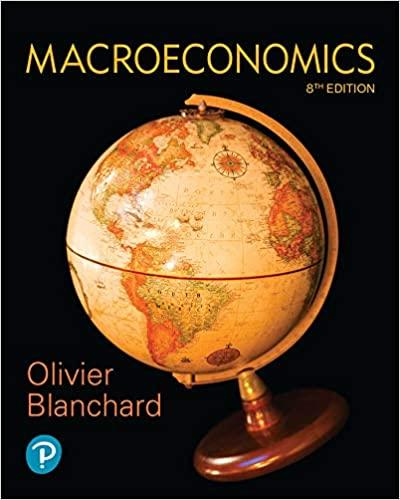A shock to aggregate supply will also have different outcomes when there are different assumptions about the
Question:
A shock to aggregate supply will also have different outcomes when there are different assumptions about the formation of the level of expected inflation. As in Question 4, one assumption is that the level of expected inflation equals lagged inflation. The level of expected inflation changes over time. The second assumption is that the level of expected inflation is anchored to the central bank's target value and never changes. Begin in medium-run equilibrium where actual and expected inflation equal \(2 \%\) in period \(t\). Then there is a permanent increase in the price of oil in period \((t+1)\).
Parts (a), (b) and (c) assume expected inflation in each period equals lagged inflation from the previous period. For example, in period \((t+2) \pi_{t+2}^{e}=\pi_{t+1}\) and in period \((t+1), \pi_{t+1}^{e}=\pi_{t}\).
a. How does the PC curve shift from period t to period \((t+1)\) ? Assume that the central bank does not change the real policy rate. What happens to output in period \((t+1)\) compared to period t? What happens to inflation in period \((\mathrm{t}+1)\) compared to period \((\mathrm{t})\) ?
b. Consider the period \((t+2)\) equilibrium under the assumption that \(\pi_{t+2}^{e}=\pi_{t+1}\) and that the central bank does not change the real policy rate. How does inflation in period \((t+2)\) compare to inflation in period \((t+1)\) ? How does output in period \((t+2)\) compare to output in period \((\mathrm{t}+1)\) ?
c. Is the policy choice to maintain the real policy rate at its period t level sustainable?
Parts (d), (e) and ( \(f\) ) assume expected inflation remains equal to target inflation, so \(\pi^{e}=\bar{\pi}\) in all periods.
d. Consider the period \((t+1)\) equilibrium given the assumption that \(\pi_{t+1}^{e}=\bar{\pi}\). If the central bank leaves the real policy rate unchanged, how does actual inflation in period \((t+1)\) compare to actual inflation in period t?
e. Consider the period \((t+2)\) equilibrium given the assumption that \(\pi_{t+2}^{e}=\bar{\pi}\) and assuming that the central bank leaves the real policy rate unchanged. How does actual inflation in period \((t+2)\) compare to inflation in period \((\mathrm{t}+1)\) ?
f. Is the policy choice to maintain the real policy rate at the period t level a sustainable policy?
Comparing the economic outcomes in parts (a), (b) and (c) to the economic outcomes in (d), (e) and (f).
g. Compare the inflation and output outcomes in part (a), (b) and (c) to that in parts (d), (e) and (f).
h. Which assumption about expected inflation, do you think is more realistic. Discuss.
Data from Question 4
Assume that expected inflation remains equal to the central bank's target rate of inflation. In the discussion of the Phillips curve, it was noted that expected inflation was, for some time, equal to lagged inflation and was not anchored by the central bank's target rate of inflation. This question considers the implications of these two assumptions about expected inflation for the effects of a permanent change in demand, given unchanged monetary policy.
The permanent change in demand studied in this question is an increase in consumer confidence where the parameter " \(a\) " takes a larger value.
One assumption is that the level of expected inflation equals lagged inflation and so changes over time. The other assumption is that the level of expected inflation is anchored to the central bank's target rate of inflation and never changes Begin in medium-run equilibrium where actual and expected inflation equals \(2 \%\) in period \(t\). Suppose there is an increase in consumer confidence in period \((t+1)\).
Parts (a), (b) and (c) assume expected inflation in each period equals lagged inflation from the previous period. For example, in period \((t+2) \pi_{t+2}^{e}=\pi_{t+1}\) and in period \((t+1), \pi_{t+1}^{e}=\pi_{t}\).
Step by Step Answer:






